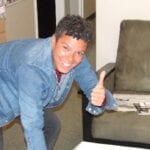So, all signed up for Queer Film Fest rehab yet?
I managed to see 15 out of its 52 offerings, well short of the number I usually take in over my favourite 11 days on Vancouver’s queer calendar.
Usually I go for broke and sit through multiple film sessions nightly that leave me so blissfully befuddled the next morning I seriously wonder if my buttered popcorn plus high fructose fountain soda was more spiked than usual… which would explain the $60 price tag. Yeah, okay… hyperbole. $40.
But if queer film festing is addictive, I’ll say a resounding no to rehab.
More than a Pride parade, more than a community rally, more than the clubs, niche-specific parties or neighbourhoods we frequent and inhabit, the Film Fest is, bar none, the annual space where the broadest spectrum of ourselves gathers for a sneak peek at our community at its best.
It’s where we allow ourselves to find and exercise the empathy for other parts of our community’s whole that we perhaps refuse, or do not take the time, to muster during the other 354 days of the year.
To rework Ross Johnstone’s quotable quote, it’s where we unpack and show off, en masse, our often-hidden triple-A rating in fabulousness.
It’s where we become much less us-and-them and instead embrace more of a “we” posture in the face of myriad reel stories that speak to our diversity, which we more easily embrace, captive — together — in the intimate darkness of theatres.
More than ever in the contemporary, we are all pulled like moth to flame to the immediacy of the visual married to compelling slice-of-life stories. What better medium than film to invade our communal skin and make us care about the issues and lives we may otherwise take for granted or dismiss as irrelevant, or just not worth our time?
Many of us may be peripherally, cavalierly, aware of the local Generations Project for example, but Gen Silent collectively moved us to a standing ovation for the unsparing spotlight director Stu Maddux threw on the gut-wrenching loneliness and fear, yet sheer grit, of queer elders in Massachusetts as they face the prospect of failing health and eventual death without family and within an often-discriminatory care facility system. In the aftermath of such real, often quiet desperation, maybe some of us will be further moved to convert the heady transiency of an ovation into local on-the-ground action.
Year after year, the fest brings home the increasing proliferation of films depicting the experiences of queers of colour globally. This year, we bore witness to the unmediated grittiness of hijra existence in Bangladesh, in Call Me Salma; the power-poverty disparities that govern the illegal but ancient practice of boy-play known as bacha bazi in The Dancing Boys of Afghanistan; the class-conscious Tunisian vehicle, The String, that produces an unlikely but joyful 180-degree turn away from familial upheaval over the same-sex relationship between the sophisticated Malik and working class Bilal. And my own obsession, I Am, Sonali Gulati’s vicarious unveiling of queer Indians’ coming-out experiences, which got me by the throat — all five times I’ve watched it so far.
Like Gulati, I never got past “I am… ” before my own mother died seven years ago. It is simultaneously a very personal and very universal experience of loss and grieving made more complicated by the sting that time’s patience had irretrievably run out on the many moments granted to come clean, now leaving only a possibility of ambiguous resolution with a hopefully compassionate but silent spirit beyond the grave.
In all these stories are kernels of reality that shock us, or that we can relate to, even as they call us to transcend our sense of what community means, who can and cannot be part of it, and more, how we may project our gaze outward, beyond a fascination with our own navels.
To Amber Dawn and the creative, hard-working folks in and supportive of Out on Screen, thank you for delivering on the happy endings you promised — but also for showing us all the possibilities as we emerge from the safety of
cocooned darkness.

 Why you can trust Xtra
Why you can trust Xtra


